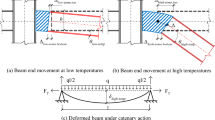Abstract
The ultimate strength of bolted and dowelled connections in timber members at ambient temperatures have been assessed using Johansen’s yield equations in Europe and USA. More recently, several researchers have begun to investigate the strength of bolted and dowelled connections at elevated temperatures. Research has been carried out at the University of Canterbury to investigate the application of Johansen’s yield equations to the prediction of the failure strength of bolted connections in fire conditions. A series of single bolted connections using steel side plates was heated at constant temperature for several hours, then loaded to failure and used to determine the embedment strength of the wood over a range of temperatures from ambient to 300°C. The temperature-dependent embedment strengths are employed in Johansen’s equations for connections using a central steel plate as well as connections using steel and wood side members. Comparisons are also being made with the results of several similar connections tested in fire conditions and show considerable promise for predicting failure of such joints. A proposal for implementation of an easy-to-use approach for the prediction of the fire resistance of bolted joints is discussed in the paper, based on an extension of the Johansen’s yield equations to fire conditions, including a model for the variation of the embedment strength with temperature.





















Similar content being viewed by others
References
Young SA, Clancy P (2001) Compression mechanical properties of wood at temperatures simulating fire conditions. Fire Mater 25:83–93. doi:10.1002/fam.759
Reszka P, Torero JL (2006) Depth temperature measurements of timber in fires. In: Proceedings of the 4th international workshop on structures in fire. Aveiro, Portugal
Jong F, Clancy P (2002) Compression properties of wood as functions of moisture, stress, and temperature. In: Proceedings of the 2nd international workshop on structures in fire. Christchurch, New Zealand, pp 223–242
Janssens M (2002) Modelling of the thermal degradation of structural wood members exposed to fire. In: Proceedings of the 2nd international workshop on structures in fire. Christchurch, New Zealand, pp 211–222
Frangi A, Mischler A (2004) Fire tests on timber connections with dowel type fasteners. In: Proceedings of the international council for research and innovation in building and construction, working commission W18—timber structures, meeting 37. Edinburgh, United Kingdom
Erchinger C, Frangi A, Mischler A (2005) Fire behaviour of multiple shear steel-to-timber connections with dowels. In: Proceedings of the international council for research and innovation in building and construction—working commission W18—timber structure, meeting 38. Karlsruhe, Germany
Erchinger C, Frangi A, Mischler A (2006) Thermal investigations on multiple shear steel-to-timber connections. In: Proceedings of the world conference on timber engineering. Portland, Oregon, USA
Racher P, Laplanche K, Dhima D (2006) Thermo-mechanical modelling of the timber connection behaviour under fire. In: Proceedings of the 4th international workshop on structures in fire (SiF’06), pp 899–908
Schabl S, Turk G (2006) Coupled heat and moisture transfer in timber beams exposed to fire. In: Proceedings of the world conference on timber engineering. Portland, Oregon, USA
Moraes PD, Rogaume Y, Bocquet JF, Triboulot P (2005) Influence of temperature on the embedding strength. Holz als Roh- und Werkstoff 63, pp. 297–302
Eurocode 5—Part 1-1 (2004) Design of timber structures. EN 1995-1-1:2004: general—common rules and rules for buildings. European Committee for Standardization. Brussels, Belgium
Johansen KW (1949) Theory of timber connections. In: International Association of Bridge & Structure Engineering. Publ No. 9:249–262. Bern, Switzerland
Eurocode 5—Part 1-2 (2004) Design of timber structures. EN 1995-1-2:2004: general—structural fire design. European Committee for Standardization, Brussels, Belgium
Carling O (1991) “Fire behaviour of metal connectors on wood structures”. Proc. Int. Conf. Timber Eng Lond 4:106–113
Lau PH (2006) Fire resistance of connections in laminated veneer lumber. Fire Engineering Research Report 06/3, 2006. Department of Civil Engineering, University of Canterbury, New Zealand. http://www.civil.canterbury.ac.nz/fire/fe_resrch_reps.shtml
Chuo TCB (2007) Fire performance of connections in LVL structures. Fire Engineering Research Report 07/4, 2007. Department of Civil Engineering, University of Canterbury, New Zealand. http://www.civil.canterbury.ac.nz/fire/fe_resrch_reps.shtml
Moss PJ, Buchanan AH, Fragiacomo M, Lau PH, Chuo T (2007) Fire performance of bolted connections in laminated veneer lumber. Fire Mater (in print)
NelsonPine NZ (2003) LVL10 design guides and span tables. Nelson Pine Industries Ltd, Richmond, Nelson, New Zealand
ISO 10984-2 (1999) Timber structures—dowel-type fasteners—part 2: determination of embedding strength and foundation values. International Standards Organization, Geneva
Franssen J-M, Kodur VKR, Mason J (2004) User’s manual for SAFIR2004: a computer program for analysis of structures subjected to fire. University of Liège, Belgium
Acknowledgements
Thanks to Nelson Pine for the supply of LVL. Thanks also to David Carshalton for conducting many embedment tests during his summer work experience at the University of Canterbury, and to Bob Wilsea-Smith and Grant Dunlop for laboratory support at the University of Canterbury.
Author information
Authors and Affiliations
Corresponding author
Rights and permissions
About this article
Cite this article
Moss, P., Buchanan, A., Fragiacomo, M. et al. Experimental Testing and Analytical Prediction of the Behaviour of Timber Bolted Connections Subjected to Fire. Fire Technol 46, 129–148 (2010). https://doi.org/10.1007/s10694-009-0096-6
Received:
Accepted:
Published:
Issue Date:
DOI: https://doi.org/10.1007/s10694-009-0096-6




